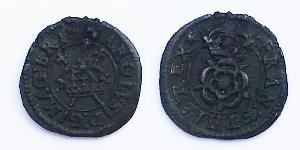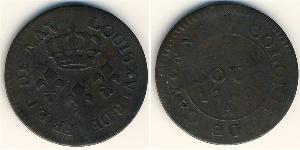(sold for $6.0)
1154, Normans in Sicily, Roger II. Rare & Tiny BI Kharruba Coin. Palermo mint!
Condition: VG-F! Mint Place: Palermo Mint Period: 1130-1154 Denomination: Billon Kharruba Reference: Travaini 237, Tarascio 88. R! Material: Billon (low grade silver & bronze alloy) Weight: 0.27gm Diameter: 9mm
Obverse: Five pellets within inner circle. Arabic legend around.
Reverse: Arabic legend.
Roger II (1093–February 26, 1154), son and successor of Roger I, began his rule in 1112. It is Roger II's distinction to have united all the Norman conquests into one kingdom and to have granted them a scientific, personal and centralized government. When William the duke of Apulia, son of Roger Borsa and grandson of Robert Guiscard, died childless in June of 1127, Roger claimed all Hauteville possessions and the overlordship of Capua. However the union of Sicily and Apulia was resisted by Honorius II and by the subjects of the duchy itself. At Capua (Dec. 1127), the pope preached a crusade against Roger, setting Robert II of Capua and Ranulf of Alife (brother-in-law of Roger) against him. However this coalition failed, and in August 1128 Honorius invested Roger at Benevento as duke of Apulia. The baronial resistance, which was backed by Naples, Bari, Salerno and other cities whose aim was civic freedom gave way. In September of 1129 Roger was generally recognized as duke by Naples, Capua, and the rest. He began at once to enforce order in the Hauteville possessions, where the ducal power had long been fading. For the binding together of all his states the royal name seemed essential, and the death of Honorius in February 1130, followed by a double election, appeared the decisive moment. While Innocent II fled to France, Roger supported Anacletus II. The price was a crown, and on the 27th of September 1130 a bull of Anacletus made Roger king of Sicily. He was crowned in Palermo on the 25th of December 1130. This plunged Roger into a ten-year war. Bernard of Clairvaux, Innocent's champion, built up a coalition against Anacletus and his "half heathen king". He was joined by Louis VI of France, Henry I of England and the emperor Lothar. Meanwhile South Italy revolted. The rebels defeated the king at Nocera on the 24th of July 1132. Nevertheless, by July 1134 his troops forced Ranulf, Duke Sergius of Naples, and the rebels to submit, while Roger was expelled from Capua. Meanwhile Lothar's contemplated attack upon Roger had gained the backing of Pisa, Genoa and the Greek emperor, each of whom feared the growth of a powerful Norman kingdom. In February 1137 Lothar began to move south and was joined by Ranulf and the rebels. In June he besieged and took Ban. At San Sevenino, after a victorious campaign, he and the pope jointly invested Ranulf as duke of Apulia (August 1137), and the emperor then retired to Germany. Roger, freed from the utmost danger, recovered ground, sacked Capua and forced Sergius to acknowledge him as overlord of Naples. At Rignano Ranulf again defeated the king, but in April 1139 Ranulf died. Roger then subdued the last of the rebels. After the death of Anacletus (January 1138) Roger decided to seek the confirmation of his title from Innocent. The pope, invading the kingdom with a large army, was skillfully ambushed at Galuccio (July 22, 1139). After the king's victory on the 25th July, the pope invested him as "Rex Siciliae ducatus Apuliae et principatus Capuae." The boundaries of the regno were finally fixed by a truce with the pope in October 1144. These lands were for the next seven centuries to constitute the kingdoms of Naples and Sicily. Roger had now become one of the greatest kings in Europe. At Palermo Roger drew round him distinguished men of various races, such as the famous Arab geographer Idrisi and the historian Nilus Doxopatrius. The king welcomed the learned and he maintained a complete toleration for the several creeds, races and languages of his realm. He was served by men of nationality so dissimilar as the Englishman Thomas Brun, a kaid of the Curia, and, in the fleet, by the renegade Muslim Christodoulos, and the Antiochene George, whom he made in 1132 "amiratus amiratorum," in effect prime vizier. This title, amiratus or emir, gave way to the English word admiral. Roger made Sicily the leading maritime power in the Mediterranean. A powerful fleet was built up under several admirals, or "emirs," of whom the greatest was George of Antioch, formerly in the service of the Muslim prince of El Mehdia. Mainly by him a series of conquests were made on the African coast (1135-53) which reached from Tripoli to Cape Bona. The Second Crusade (1147-48) offered Roger an opportunity to revive Robert Guiscard's designs on the Greek Empire. George was sent to Corinth at the end of 1147 and despatched an army inland which plundered Thebes. In June 1149 the admiral appeared before Constantinople and defied the Byzantine emperor by firing arrows against the palace windows. Yet the attack on the empire had no enduring results. The king died at Palermo on the 26th of February 1154, and was succeeded by his fourth son William.
Only 1$ shipping for each additional item purchased!

|
Posted by:
anonymous 2018-05-30 |
1/2 Thaler Kingdom of Hungary (1000-1918) Silver Leopold I, ...
group has 4 coins / 4 prices
⇑
















-300-150-qkIKbzbi_WsAAAFLvFWjltiJ.jpg)






